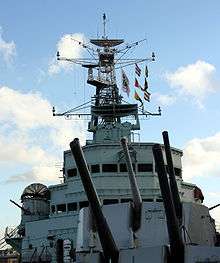Recognition signal

A recognition signal is a signal where a person, a ship, an airplane or something else is recognized. They can be used during war or can be used to help the police recognize each other during undercover operations. It can also be used in biology to signal that a molecule or chemical is to be bound to another molecule.
War
These signals are often used to recognize friends and enemies in a war.[1] For military use these signals often use colored lights or the International marine signal flags
Police
Other uses of the signal include the police who sometimes use a recognition signal so that officers in uniform can recognize officers in normal clothing (undercover).[2][3] The NYPD often use headbands, wristbands or colored clothing as recognition signals which are known as the "color of the day".[3]
Biology
A recognition signal is also a chemical signal used in biology to signal the end of a section of DNA or RNA during gene duplication in cells.[4]
See also
Notes
- ↑ Commander-in-Chief High Sea Fleet (German navy. "German Navy Tactical Orders (Enemy Recognition Signals)". Retrieved 2009-02-18.
- ↑ James, George (24 August 1994). "Police Agencies Share Rules for Recognition". New York Times. Retrieved 2008-09-17.
- 1 2 Krauss, Clifford (24 August 1994). "Subway Chaos: Officer Firing at Officer". New York Times. Retrieved 2008-10-05.
- ↑ Joachim Krieg; Steffen Hartmann; Anna Vicentini; Wolfgang Gläsner; Daniel Hess; Jan Hofsteenge. "Recognition Signal for C-Mannosylation of Trp-7 in RNase 2 Consists of Sequence Trp-x-x-Trp". Retrieved 2009-02-19.
External links
| Wikimedia Commons has media related to International Code of Signals. |